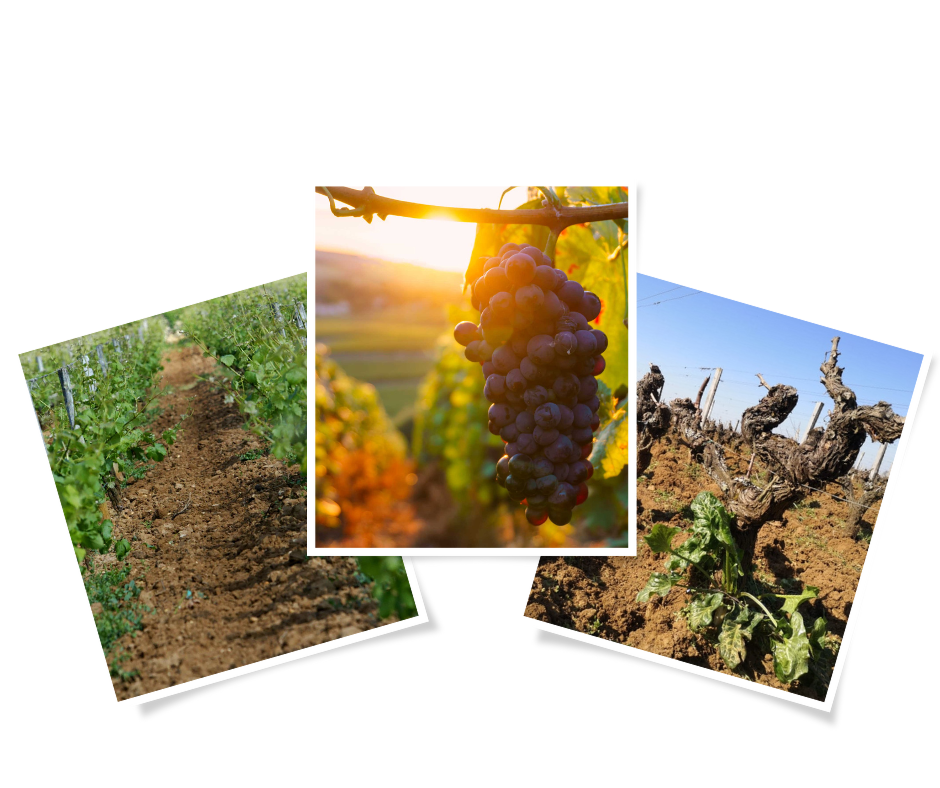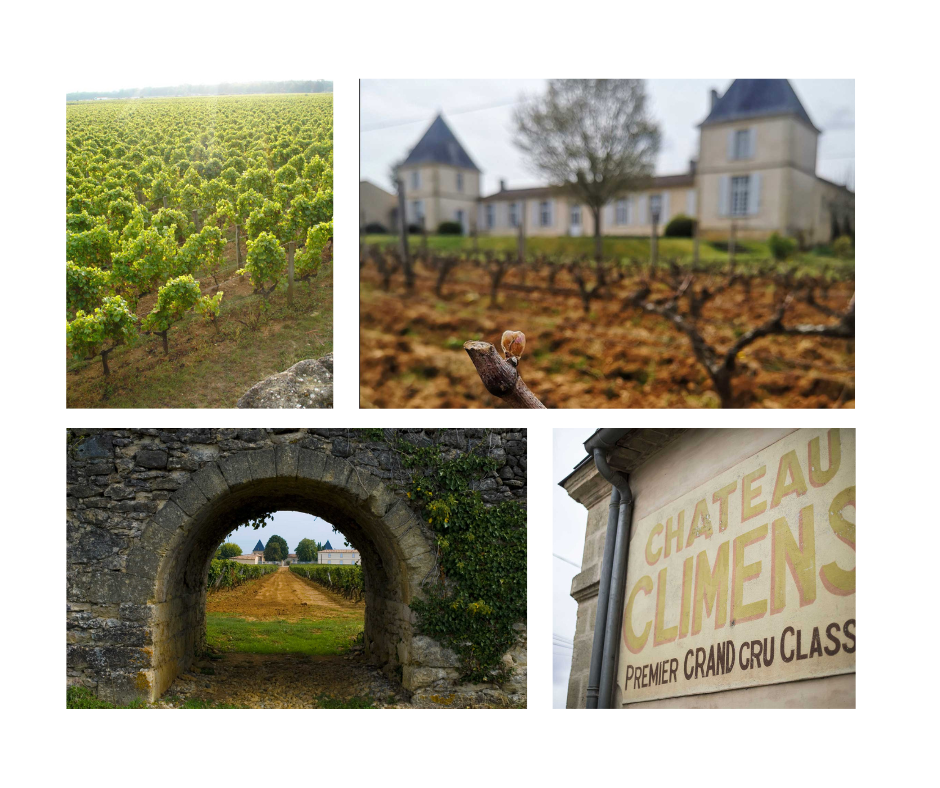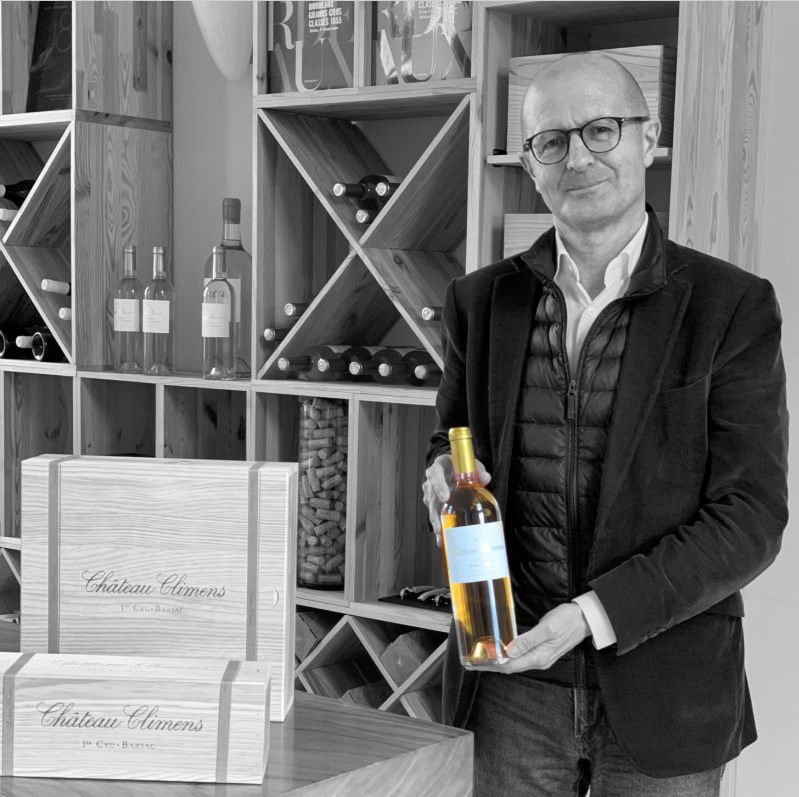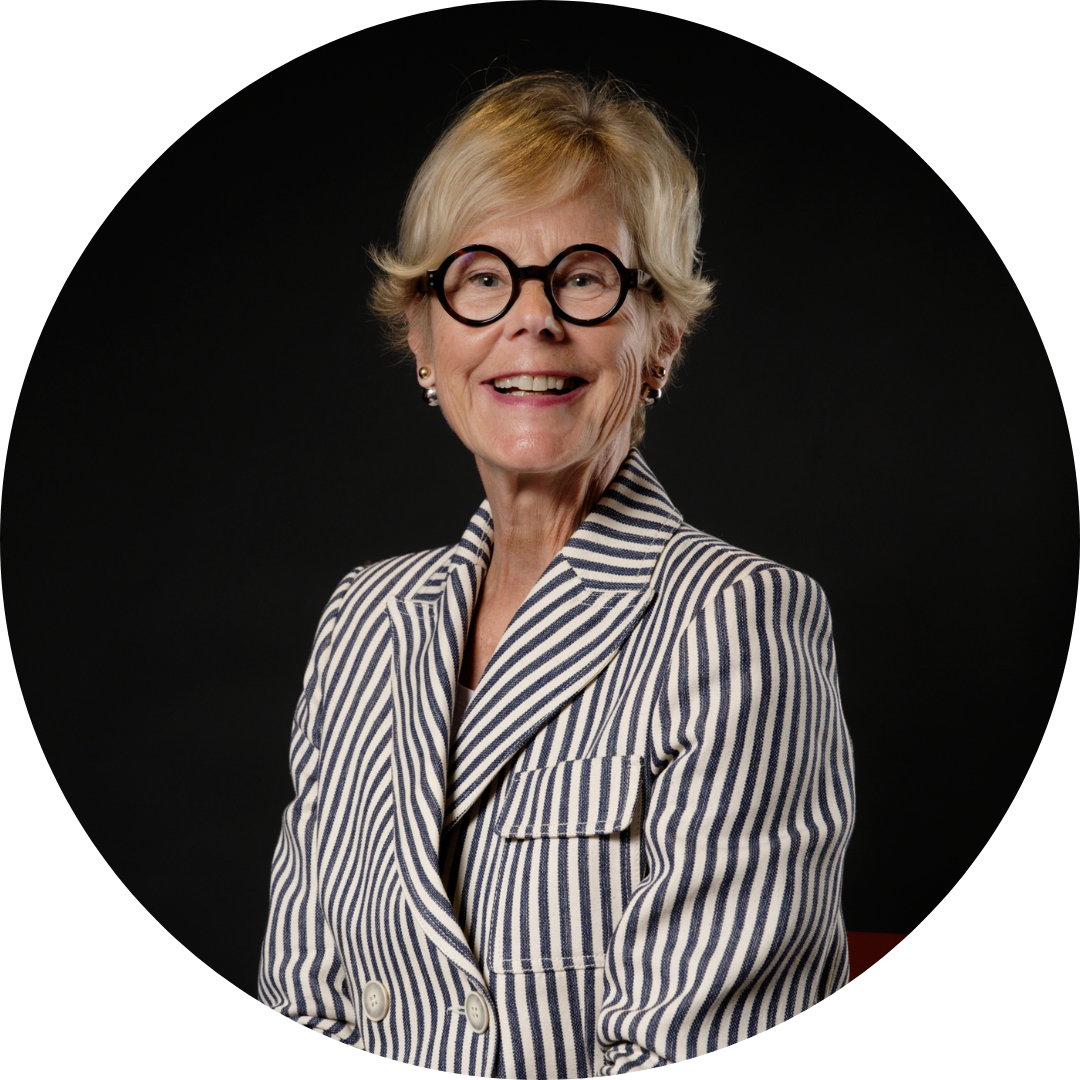Jérôme Moitry
Managing Director
Château Climens
Premier Cru Classé Barsac Sauternes
Gerda: Tell us about yourself…
Jérôme Moitry: I’m going to talk about my brother and myself, as I accompanied him in this magnificent acquisition. We come from Nîmes, with a father from Lorraine and a mother from Spain. My brother graduated from the Ecole Normale Supérieure in Classics and also studied international law. He founded his group specialising in commercial property in France over 25 years ago. His wife is from Corrèze, and one of her ancestors was a wine merchant in Meymac-près-Bordeaux. This explains their strong taste for Bordeaux wines. For a number of years we had been talking about acquiring a wine business, and naturally we wanted to do it in the Bordeaux region.
My background is different. After studying in Nîmes and then Montpellier, I was admitted to the Ecole Centrale de Paris to study engineering. I continued my studies in the United States and later joined INSEAD for an MBA. I worked for 20 years in strategy consulting in 25 different countries in the telecoms and energy sectors. Just over ten years ago I left my consultancy to embark on new activities. I quickly joined my brother to develop the third-party asset management business. I am a founding partner and director of Patrimonia Capital, an AMF-approved asset management company that invests in property and hotels.
I’m also very involved with my alma mater. I’m treasurer of the CentraleSupélec Foundation and I’ve invested a lot in the development of student residences on the Saclay plateau. It’s voluntary work, and it takes up a bit of my time, but I think that at a certain age, you’ve been lucky enough to be helped in your life, and you have to start giving back to the next generation. In short, as you can imagine, I don’t have a classic vision of retirement where you stop at 60 and read the paper in the morning then play golf in the afternoon!
My love of wine goes back a long way. I spent my childhood surrounded by the vineyards of the Costières region, so naturally I was able to discover the fine wines of neighbouring Châteauneuf-du-Pape. At the École Centrale, I was taught by Bernard Burtschy, who was a professor of statistics at the time and who was already getting us to do data analysis on wine. Living in Paris, I learned a lot at the Grains Nobles tasting club. Coming from a family that loved to read, I also learned a lot that way. And during my many trips and travels I was able to discover wines from all over the world.
Three years ago, my brother and I started looking into the possibility of acquiring vineyards in the Bordeaux region. When the opportunity arose to buy Climens, we quickly fell under the spell of this property and its exceptional terroir.
G: What are the main challenges you face personally in your job?
JM: My main challenge was to enter this new profession, to establish a working relationship with the Climens team, to integrate myself and to be able to develop a vision and a new strategy for the domain. When you’re starting out in a new profession, in which you can’t rely on empirical knowledge passed down from generation to generation or on academic training, you need to acquire a minimum of knowledge and credibility very quickly. I think that my eclectic experience in wine and my extensive reading on the subject have provided me with a good knowledge base. Then, in terms of method, the chess games of my youth, my engineering training and my varied professional experience have enabled me to develop very useful analytical and synthesis skills. As a consultant, I often had to work with technical experts in fields that I didn’t initially master, and I had to develop the ability to work closely with them. Knowing how to ask the right questions and make the right analogies, in order to find solutions to the problems encountered. My aim is clearly not to become a winemaker. That’s the area of expertise of Frédéric Nivelle, our man of the art, who has been at Climens for over 25 years, and his team. My role is to lead the team in solving problems and initiating change.
For example, the first concrete, immediate and urgent challenge was to find a solution to deal with the frost, which had prevented the production of three of the previous five vintages. I was surprised to find that there was no obvious solution, which led me to explore different options. In the end, we opted for removable anti-freeze wind turbines and pellet-based heat sources, discovered at Jacky Blot’s vineyard in the Loire. This solution meets both aesthetic and environmental criteria, an important point if we are to fit in with the biodynamic approach adopted by Climens in 2010.
Another challenge to which I am attentive is integration into our ecosystem. I’ve spent a lot of time meeting our neighbours and all those involved in our environment. My brother and I have joined the Commanderie du Bontemps, and Climens has rejoined certain groups, such as the conservatoire des cépages du sauternais. I sit on the board of directors of the Sauternes and Barsac Crus Classés. The last group we could join is the Union des Grands Crus, but it’s not on the agenda because we couldn’t, under its current operating rules, present our dry white wines there.
In fact, our strategy is based on two pillars: the sweet 1er cru classé, which conveys the estate’s brand image, and the new range of dry white wines, which is a priority for commercial development. Although it will take time, we are seeing a growing demand for the latter, just as we did a few centuries ago for sweet wines. We have an exceptional terroir for producing excellent wines from the Sémillon grape variety. It’s a relatively unknown grape variety, and I didn’t know much about it before I came to Climens. I’m now convinced of its extraordinary potential for making great white wines, which is uniquely expressed in the Haut Barsac terroir.
Harvest 2023
 G: Can you give me a memory of the 2023 harvest?
G: Can you give me a memory of the 2023 harvest?
JM: I’d like to talk to you about the 2022 vintage because it was my first here at Climens, a real discovery. You can’t talk about a sweet wine without talking about the weather. For 2022, the highlight was the heat and lack of rain in September. The grapes became more concentrated and the final yield was relatively low, 7.5 hl/ha. September was a strange month in that we had a few morning mists at the beginning of the month, but the botrytis didn’t arrive. Botrytis arrived at the beginning of October. And from then on, everything went very fast. We finished in a weekend what we hadn’t done before. That’s how I discovered the impact of climate change.
I’d heard that the sweet wine harvest had started earlier in recent years. As a good engineer and a believer in science and facts, I researched and analysed the start dates of the harvest over the last 80 years in order to verify the fact and… we realised that, in the end, it wasn’t true: botrytis arrives at roughly the same time and the harvest starts on average around 25 September. That’s not the problem, it’s rather that the grapes are riper than before. This is reflected in the harvesting of the dry whites, which starts in the second half of August, several weeks earlier than before.
So when the botrytis arrives, all the grapes are ripe, so it affects the whole vineyard in the same way. We had to move very quickly to pick up the whole crop, often in two selections. In the past, harvesting sweet wines was a marathon, punctuated by numerous passes, the famous selections, but now it’s a sprint! And, of course, the yield is lower because the grapes are more concentrated.
As for 2023, we had another problem with the weather in June. It was a very wet month with tropical temperatures, which led to the appearance of mildew, certainly one of the recurring problems for the future, especially for a biodynamic vineyard. We had a major loss on the old vines, not so much on the young ones. As a result, the harvest of dry white wines was not too badly affected. For a different reason in 2022, we will also have a very low yield for sweet wines, at just 2.7 hl per hectare. We need to get used to the small yields required to make the ultra-nectar, Premier Cru Classé Barsac de Climens.
The Climens brand today and tomorrow
G: What positioning(s) would you like to see for Château Climens?
JM: Climens is a fine brand, but we’re not a big brand by luxury industry standards. On our own scale, we have a brand based on a 30-hectare vineyard, with relatively modest production, and an excellent reputation among wine lovers, which is a remarkable starting point. I started from the principle that sweet wines were so beautiful, so magnificent, that it was above all a question of perpetuating this product while respecting its history, but I did have a problem with the positioning of the brand and therefore its price. I’m convinced that, in the long term, a quality brand can’t survive if the price doesn’t match the brand’s image. There has to be a correlation between brand image and price.
Over the last fifteen years, as a result of consumers’ disenchantment with sweet wines, there has been a disconnect between the price of our sweet wines, grands crus classés from Sauternes, and the quality of the product. Many wines from average terroirs, but benefiting from good work by the winemakers, have fetched higher prices than our wines, even though they come from exceptional terroirs, as the 1855 classification has shown. That’s why we decided to reposition the price of the 1er cru. What we have done for the 2022 primeurs is not therefore a pure increase or variation in price according to the state of the market, but a repositioning that is intended to last.
We will release approximately one-third of our production each year as primeurs. The rest will be sold later. We have a good stock of old vintages that can be marketed over the coming years, which will allow us to make two releases a year, one en primeur and one old vintage. We had planned to release an old vintage in the spring, but the market conditions were not right, so we are waiting for the right moment.
As far as dry whites are concerned, we have an exceptional terroir, and we’re looking to produce the best possible dry white wines. Bérénice Lurton had started this process with Asphodèle and we decided to continue and enrich it. Since our arrival, we have created Lilium, our great dry white, matured in Wineglobes, and Petite Lily, a first accessible dry white, whose production currently stands at 25,000 bottles and is set to grow. We are also considering acquiring additional plots on the Haut-Barsac plateau, where the terroir is similar, in order to increase production, particularly of Petite Lily. Our strategy is therefore to take our Climens Premier Cru Classé and our Grand Blanc Sec Lilium to the next level of excellence, and to make Petite Lilly a more accessible way of discovering our terroir and Semillon, which will also contribute to the Château’s economy.

The Château Climens range of wines
G: What is your advantage in working with Place de Bordeaux?
JM: When I arrived, I heard a lot of criticism about the Place de Bordeaux, often linked to general ‘Bordeaux bashing’. However, after looking around the marketplace and carrying out my own analysis, I feel that it is an extraordinary distribution tool, offering an unrivalled global reach for fine wines. It’s much more than just a logistics platform; it’s an extraordinarily powerful marketplace that ensures a highly capillary distribution network for our wines. So it would be a shame not to take advantage of it. Our historic relationship with the Bordeaux marketplace is a precious asset, and we need to take advantage of it.
The Place distributes our Climens and Lilium Grands Vins openly, to ensure the widest possible distribution of these wines. On the other hand, we have to recognise that La Place is finding it more difficult to promote new wines that are not yet well known on the international markets. We have therefore decided to distribute our dry whites on an exclusive country-by-country basis, to ensure that local distributors are motivated. This does not preclude working with the Place, as we do in certain markets where there is a strong relationship between the local distributor and a Bordeaux négociant.
As we’ve developed this network, we’ve realised that finding good distributors isn’t always easy, even if you’re a Premier Cru Classé. Some countries already have a very rich and diversified offer, and Bordeaux whites are not always recognised or given priority. As far as we’re concerned, we have a lot of extra work to do to get our wines tasted, because we make a 100% Semillon wine from a limestone terroir and without wood, which is very atypical for Bordeaux. However, we’ve made good progress and found a good number of partners willing to promote our wines, but there are still a few countries to cover.
G: Château Climens went biodynamic in 2010. Are organic or biodynamic viticulture compulsory for a Grand Cru or does everyone do as they please?
JM: Biodynamics is not a dogma for me, but a pragmatic observation. I discovered biodynamic viticulture as a taster, and have been following it for over 25 years. It’s clearly a good way of making wine, because it gives good results, expressing the terroir and the grape varieties in a very pure way. I read Goethe, then Rudolf Steiner, whose courses were aimed at farmers, not winegrowers. Admittedly, not everything about biodynamic viticulture is clear, but there are two fundamental elements that are very interesting to me, because they echo my own personal experience:
- Firstly, phytotherapy, and its prophylactic benefits, which means strengthening the plant’s immune defences rather than treating it when it’s sick. As my doctor is a phytotherapist, I’m naturally very sensitive to this. Let’s not forget that medicine in many countries is based on plants, in China and India, and that it was also used in our own country in the days of the Druids.
- Then there’s the influence of the planets. I calculated the tides in my scientific studies and we all know the effects of the moon on the earth. In my case, I sleep badly on the evenings when the moon is full, so it’s hard not to imagine that the vine also feels the effects. When I was on a research placement at IBM in the United States nearly 40 years ago, I studied solar cycles, and we are only just beginning to measure and understand the effect of these 11-year cycles on the earth. What is certain is that the influence of the planets on the earth is real, but that we still haven’t understood their influence on nature and on us.
For the first time, INRAE has looked into the subject and carried out a serious study of soil life. The results clearly show the benefits of biodynamic viticulture for soil life, compared with other farming methods. The Ecovitisol study is being replicated this year in the Bordeaux region.
The reality is that, while we see the benefits of this method of cultivation, we don’t really understand how biodynamics works. I have to say that the debates surrounding biodynamics shock me deeply because they give free rein to the worst extremes. Should we reject a practice like biodynamics just because we don’t know how it works? As sons of enlightenment, shouldn’t we try to understand before judging? And above all, as good pragmatists, why should we reject a practice that works?
Having said that, biodynamic viticulture is one practice among many. There are many initiatives today, particularly in Bordeaux, aimed at growing vines with greater respect for nature; this is a very good thing, but there is still a lot to learn in this area.
For example, we have just completed an assessment of our biodiversity with the Derenoncourt firm, along with an entomologist, a botanist, and an ornithologist. The results are already very positive, it’s a good starting point, and we’re going to draw up an action plan to go even further in terms of this biodiversity, which is so critical when you’re in monoculture.

The Business
G: What are your priorities in terms of business development?
JM: Our priorities are to:
- Maintain our position as a Premier Cru Classé with our new strategy of two releases a year, combining the en primeur release with the release of an old vintage. And to underpin our new pricing strategy with a scarcity of supply. It’s essential that our new price, about half that of Yquem, which we think is the right level, is accepted by the market.
- To showcase the quality of our great dry whites. I’m convinced that Lilium can compete with the best. To do this, we need the help of the Bordeaux marketplace. At the moment, there’s strong demand for dry whites, and the Place de Bordeaux needs to promote these great whites to show that Bordeaux produces exceptional white wines. Comparative tastings, even blind tastings, would also be an interesting way of demonstrating the quality of our products.
G: What sales aids are available to distributors to promote your wines?
JM: We are craftsmen, our work is on the estate, it’s all about people, but of course we provide our distributors with a range of media to promote our wines, including brochures and detailed technical data sheets…. We have a dedicated sales manager, Paul Marchais, who can help with the sales process. We also travel to the most important markets to support distribution and we are available to meet all your needs.
In addition, we believe in bringing our customers closer to Climens and offer exceptional reception experiences here at the Château, including lunches or dinners prepared by top chefs. These experiences offer visitors a memorable souvenir and a deeper understanding of our estate and wines. The feedback we receive is very positive, and we are delighted to offer this opportunity to passionate wine lovers.
Favorite bottle of Jérôme Moitry
G: If you had just one favourite bottle?
JM: I’m quite eclectic. I love the Mourvèdre in Bandol, for example, or the Terrebrune, which expresses its Triassic limestone terroir so well. As far as Climens is concerned, it’s difficult to mention just one vintage because they’re all different and beautiful, so this will be the last one that we tasted with Michel Bettane at the Château and shared widely during the primeurs because it’s very similar to the 2023. We have chosen the 2014, which at the time of its release did not appear to be one of the great vintages, and yet, ten years later, is garnering some very fine appreciations and scores. This is a true Barsac and Climens, full of freshness, elegance, finesse and clarity, with a remarkable luminosity. It’s a lovely sparkle. It’s beautiful, it’s vibrant, it’s delicious.
Gerda BEZIADE has an incredible passion for wine, and possesses a perfect knowledge of Bordeaux acquired within prestigious wine merchants for 25 years. Gerda joins Roland Coiffe & Associés in order to bring you, through “Inside La PLACE” more information about the estate we sell.


